Spain, Gibraltar and Morocco
A trip from March 24 through April 12, 2008
| Sevilla, with its Alacazar and Cathedral |
|
| This
is a bank building in Seville, built in the 1920's. It shows an
ongoing influence of the Moorish styles on Spanish architecture. |
|
| Palacio
de San Telmo is an example of Sevillian baroque architecture.
When it was built, between 1628 and 1734, it was a school for
navigation. However, based on a royal decree, it became a
seminary for priests in 1897. |
|
| One
of the key attractions in Seville is the Alcázares Reales, a set
of royal buildings. The Puerto de Leon (Lion's Gate) is the
principal entry to the compound. It appears we were not the
only tour group in Seville. | |
| This
is the Patio de las Doncellas, courtyard of the maidens. This is
the center of the palace of King Pedro I of Castille. Also known
as Pedro the Cruel, he reigned between 1350 and 1369. (The Moors
lost Seville in 1248.) This courtyard is surrounded by very
gracious chambers, the official staterooms. Carlos V (1516
- 1556) built the second story, from which the young ladies could
observer their elders being royal. | |
| The Hall of the Ambassadors adjoins the Patio de las Doncellas, and this ceiling is known as the "Half Orange." Just a part of the decorations in this formal room. | |
| A ground level view of Patio de las Doncellas, with its reflecting pool, and a sunken garden that was discovered in 2004. At one point, it had been paved over. | |
| One of the arches seen from the Patio de las Doncellas. | |
| The Alcázares Reales includes a number of formal gardens. This is just a corner. | |
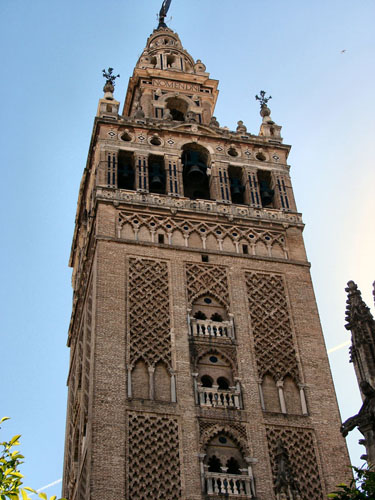 | Just
outside of the Alcázares Reales is the Cathedral of Santa Maria,
which was built between 1401 and 1501 on the site of a large Mooring
mosque. This is a case of cathedral envy, and part of the goal
was to out shine the cathedral in Toledo. The result is the
largest Gothic cathedral in the world, and third largest church, after
St. Peters (Rome) and St. Paul's (London). This is the Giralda, a great case of recycling. This was the minaret for the Moorish mosque, and the cathedral builders added the top gallery. Now it is the cathedral tower. |
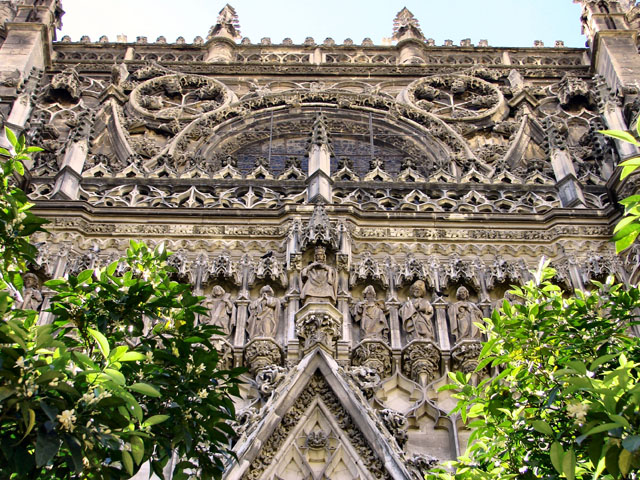 | Part of the entry to the Seville Cathedral. |
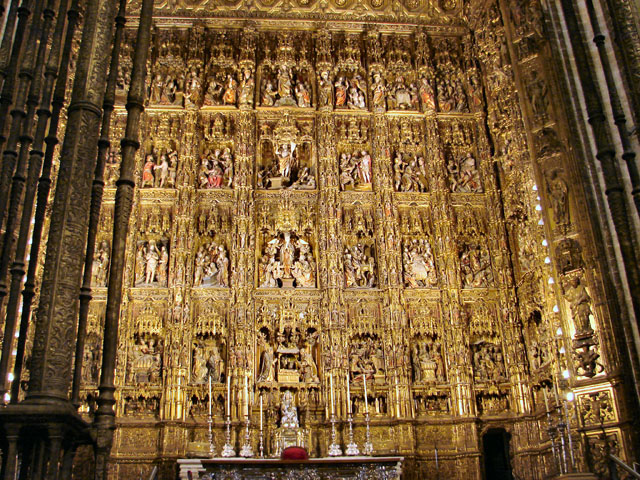 | This
is the retable at the high altar in the Capilla Mayor. It is only
91 feet high. It was another 100-year project. |
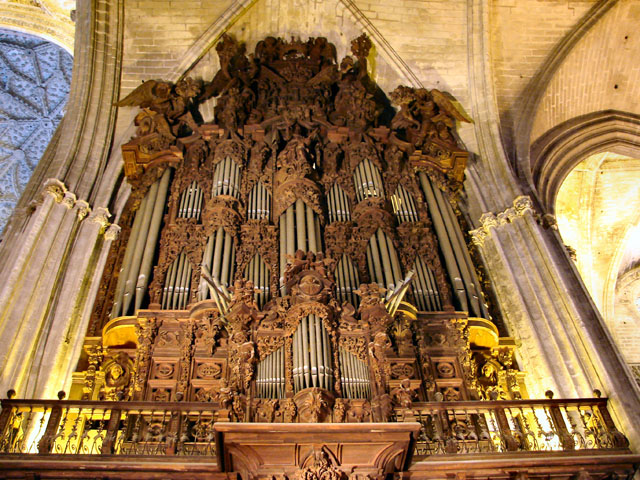 | One of two spectacular baroque organs in the Cathedral of Santa Maria. |
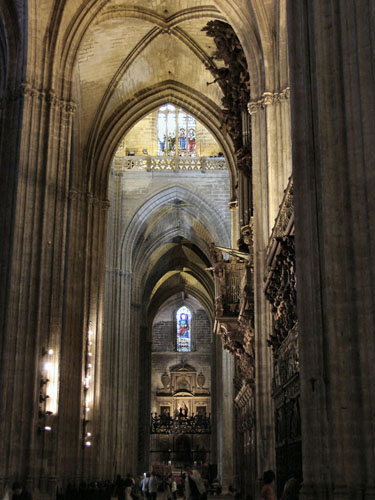 | Looking down the nave of the Seville Cathedral. |
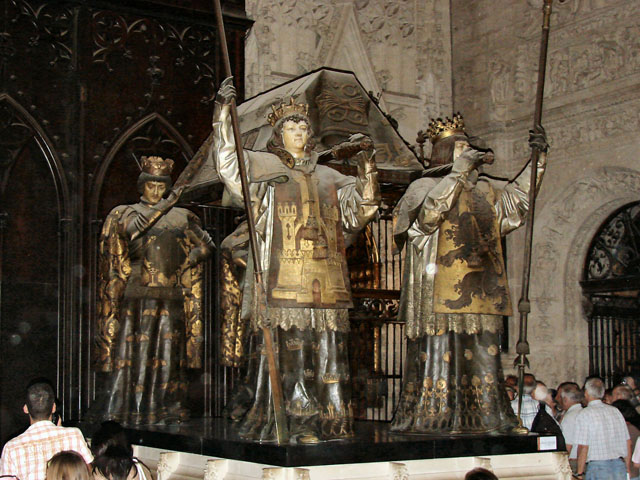 | Christopher
Columbus died in 1506, and his remains rambled back and forth across
the Atlantic. He had wanted to be buried on the Caribbean island
of Santo Domingo. Carlos V allowed that, and his remains were
subsequently transferred to Cuba, maybe. His remains, the Cuba
version, were transferred back here in the 1890's and placed in
this 1900 tomb. The four heralds are represent the four kingdoms
of Spain. |
| Cordoba and the Mezquita | |
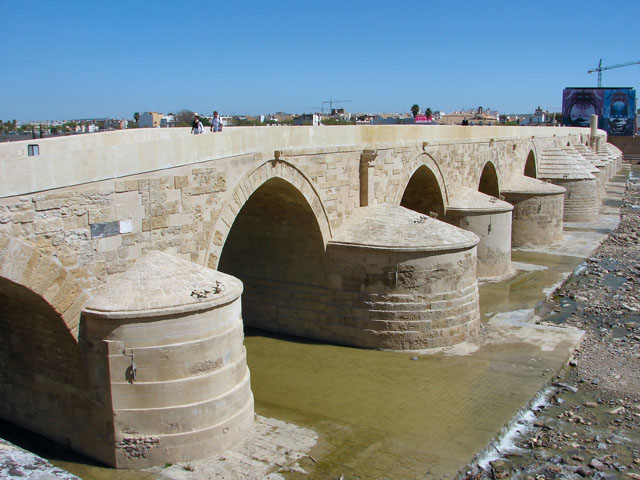 | This is known as the Roman Bridge, and once it was. However, what we see today is a reconstruction. |
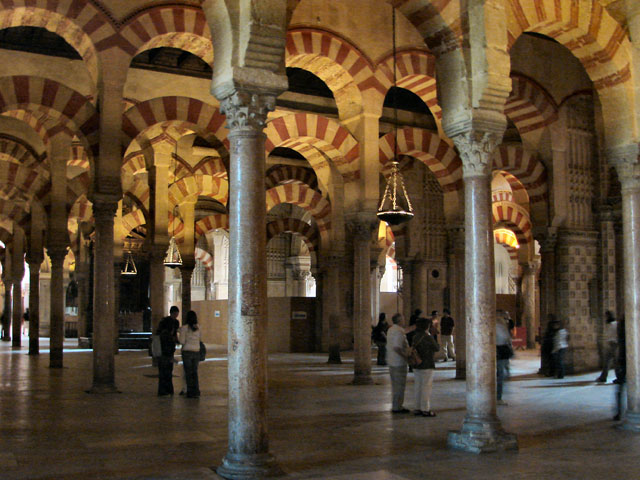 | The
Mezquita, meaning Great Mosque, was built in stages over three
centuries (starting in 785) to become the greatest mosque in the 14th
century Muslim world. Since Cordoba was the capital of Moorish
Spain, the size was justified. The space enclosed by the Mezquita
is more than 5½ acres. |
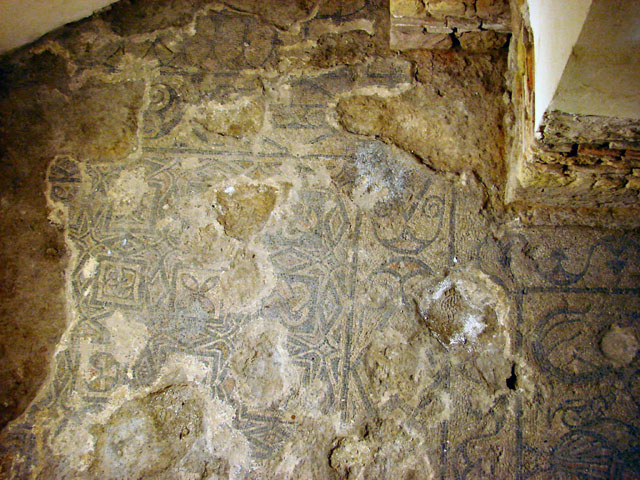 | The
Romans had erected a temple on this site. Later, the Visigoths
used the site for their basilica dedicated to St. Vincent. When
the Moslem arrived in 711, the converted a bit of St. Vincent's, but
later built over it. This excavated floor dates back to the
Visigoths and St. Vincent's Basilica. |
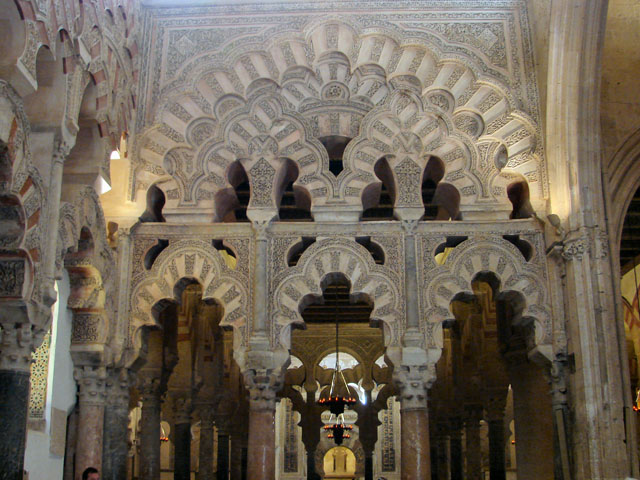 |
Today,
this is called the Capilla de Villaviciosa, but the construction goes
back to al-Hakam II, Caliph of Cordoba from 961 to 976. It was
the entrance to his prayer room. |
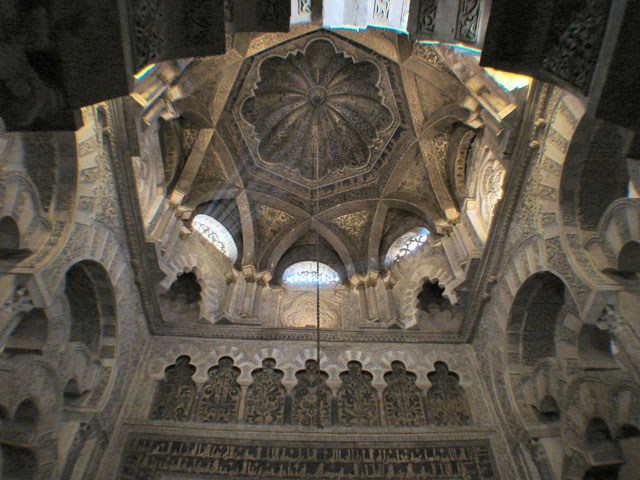 |
Al-Hakam II also had this dome built to the area of the mosque just in front of the Mihrab, below. |
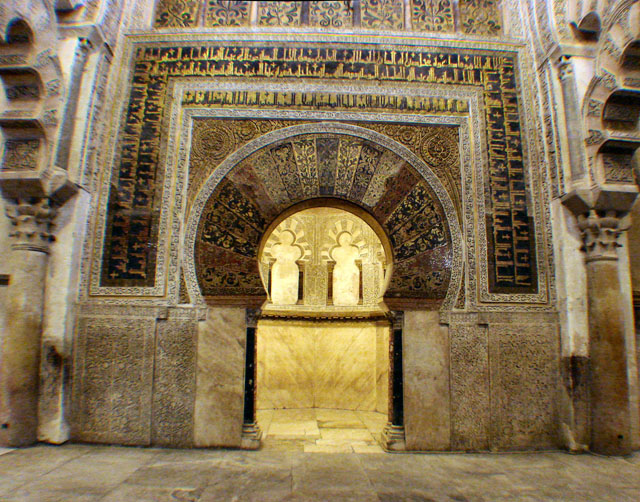 |
Al-Hakam
had specialists come in from Byzantium to create this mihrab, a chamber
from which the imam of the mosque would pray. It was completed in
965, and it is carefully aligned to face Mecca, more carefully aligned
than the balance of the mezquita. Its shape is intended to
amplify the imams voice. |
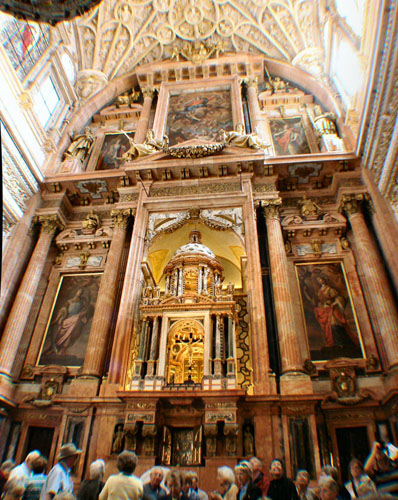 |
In
1523, the Catholic church of Cordoba authorized the construction of a
cathedral smack in the middle of the Mezquita. It sticks out the
top, because cathedrals are tall. |
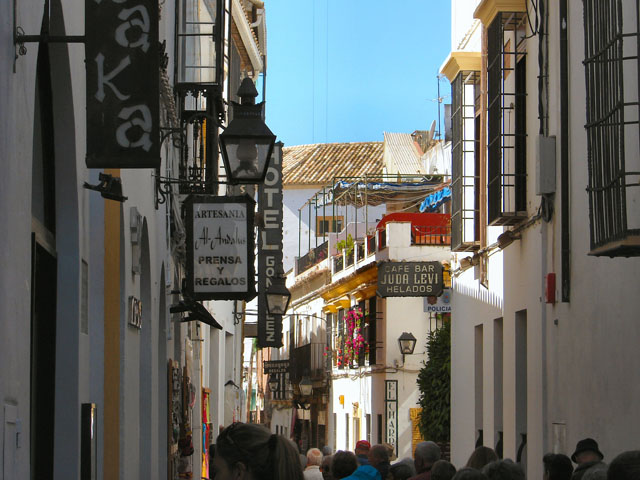 |
Adjacent
to the Mezquita, there is a Jewish neighborhood. From 70 AD
through the 13th century, Jews streamed into Andalusia. Before
Ferdinand and Isabella, Jews played a significant role in Spanish
society, and Cordoba had the largest Jewish community in Spain during
the caliphate. This street leads into the old Jewish
quarter. Navigation through here is not for the idle tourist. |
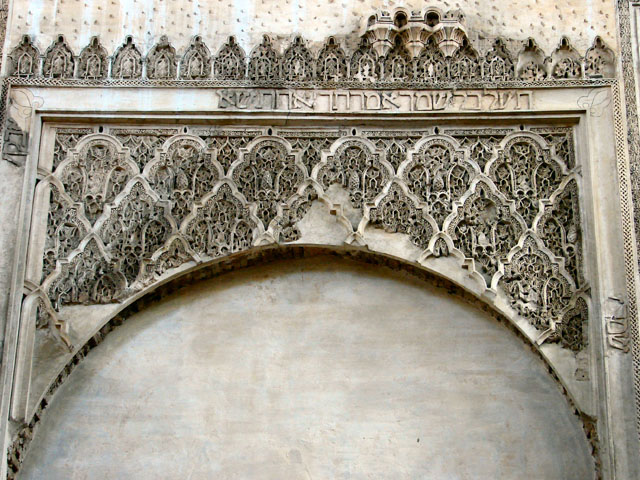 |
This
synagogue was built during Seville's Christian era, around 1315, by
Moorish craftsmen. It is the only synagogue in southern Spain
that remains intact. It had its ups and downs. After 1492, when all
the Jews were kicked out, this became a rabies hospital; the shoemakers
guild later used it as a chapel. Still, a bit of Hebrew appears above
the door. |
| Tarifa and Leaving Spain |
|
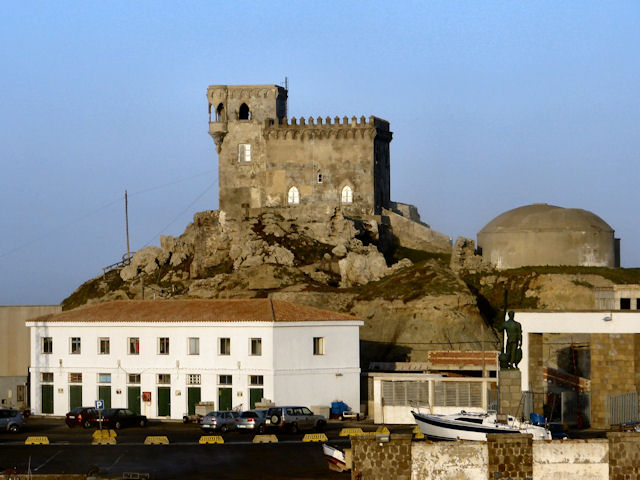 |
This
battlement overlooks the harbor in Tarifa. Tarifa is the town
closest to Morocco, and it was here that the Moors first landed in
711. They proceeded across the country at lightning speed after
that. For us, Tarifa was the place where we caught a ferry that took us from Europe to Africa in about 30 minutes. However, before leaving for Morocco, we had a visit to Gibraltar. |
| Back Home |
Back to Granada |
Forward to Gibraltar |
Back to Top |